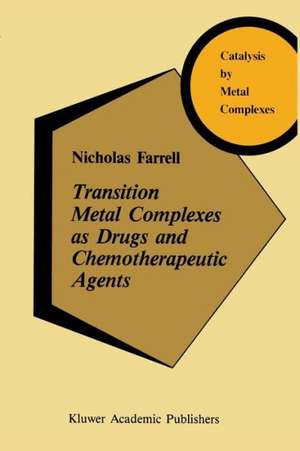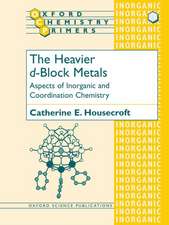Transition Metal Complexes as Drugs and Chemotherapeutic Agents: Catalysis by Metal Complexes, cartea 11
Autor N. Farrellen Limba Engleză Paperback – 15 mar 2012
Din seria Catalysis by Metal Complexes
- 15%
 Preț: 640.06 lei
Preț: 640.06 lei - 15%
 Preț: 589.30 lei
Preț: 589.30 lei - 18%
 Preț: 954.45 lei
Preț: 954.45 lei - 18%
 Preț: 1227.36 lei
Preț: 1227.36 lei - 18%
 Preț: 1228.47 lei
Preț: 1228.47 lei - 18%
 Preț: 1832.08 lei
Preț: 1832.08 lei - 18%
 Preț: 1386.62 lei
Preț: 1386.62 lei - 15%
 Preț: 593.89 lei
Preț: 593.89 lei - 15%
 Preț: 644.30 lei
Preț: 644.30 lei -
 Preț: 399.88 lei
Preț: 399.88 lei - 18%
 Preț: 948.16 lei
Preț: 948.16 lei - 18%
 Preț: 1234.62 lei
Preț: 1234.62 lei - 18%
 Preț: 1230.53 lei
Preț: 1230.53 lei - 18%
 Preț: 1225.62 lei
Preț: 1225.62 lei - 18%
 Preț: 1229.73 lei
Preț: 1229.73 lei - 18%
 Preț: 944.82 lei
Preț: 944.82 lei - 18%
 Preț: 945.30 lei
Preț: 945.30 lei -
 Preț: 384.31 lei
Preț: 384.31 lei - 18%
 Preț: 958.38 lei
Preț: 958.38 lei - 18%
 Preț: 952.89 lei
Preț: 952.89 lei - 18%
 Preț: 952.40 lei
Preț: 952.40 lei - 18%
 Preț: 946.55 lei
Preț: 946.55 lei - 18%
 Preț: 1113.58 lei
Preț: 1113.58 lei - 18%
 Preț: 948.61 lei
Preț: 948.61 lei - 18%
 Preț: 950.84 lei
Preț: 950.84 lei - 18%
 Preț: 1217.90 lei
Preț: 1217.90 lei
Preț: 387.75 lei
Nou
Puncte Express: 582
Preț estimativ în valută:
74.20€ • 77.31$ • 61.43£
74.20€ • 77.31$ • 61.43£
Carte tipărită la comandă
Livrare economică 03-17 aprilie
Preluare comenzi: 021 569.72.76
Specificații
ISBN-13: 9789401175708
ISBN-10: 9401175705
Pagini: 304
Ilustrații: 304 p.
Dimensiuni: 152 x 229 x 16 mm
Greutate: 0.41 kg
Ediția:Softcover reprint of the original 1st ed. 1989
Editura: SPRINGER NETHERLANDS
Colecția Springer
Seria Catalysis by Metal Complexes
Locul publicării:Dordrecht, Netherlands
ISBN-10: 9401175705
Pagini: 304
Ilustrații: 304 p.
Dimensiuni: 152 x 229 x 16 mm
Greutate: 0.41 kg
Ediția:Softcover reprint of the original 1st ed. 1989
Editura: SPRINGER NETHERLANDS
Colecția Springer
Seria Catalysis by Metal Complexes
Locul publicării:Dordrecht, Netherlands
Public țintă
ResearchCuprins
Metals in Medicine.- Chemotherapeutic Agents and Drugs.- Mechanisms of Toxicity.- Metal Accumulation and Activation.- Biochemical Targets for Metal Complexes.- Summary.- References.- 1. Interaction of Metal Complexes with DNA.- 1.1. DNA and Conformation.- 1.2. Experimental Methods for the Study of Conformational Changes.- 1.3. Binding of Metal Complexes to DNA.- 1.4. Summary.- References.- 2. Platinum—Amine Complexes as Anticancer Agents.- 2.1. The Discovery of Cisplatin as an Antitumour Agent.- 2.2. Clinical Properties of Cisplatin.- 2.3. Development of Cisplatin Analogues.- 2.4. Biochemical Mechanism of Action of Platinum Complexes.- 2.5. Summary.- References.- 3. Structure—Activity Relationships of Platinum— Amine Complexes.- 3.1. The Requirement for Neutrality.- 3.2. Complexes of Pt(IV).- 3.3. Nature of the Leaving Group.- 3.4. Nature of the Nonleaving Group.- 3.5. Novel and Targeted Approaches to [PtX2(am)2] Complexes.- 3.6. Quantitative Structure—Activity Relationships.- 3.7. Chemistry of Platinum—Amine Complexes.- 3.8. Summary.- References.- 4. Interactions of Platinum Complexes with DNA Components.- 4.1. Structural Aspects of Metal—Nucleobase Binding.- 4.2. Reactivity of Platinum Metal—Base Complexes.- 4.3. Solid State Structural Studies.- 4.4. Structural Studies on Di- and Oligonucleotide Complexes.- 4.5. Platinum Adducts from DNA Degradation.- 4.6. On the Molecular Mechanism of Antitumour Action of Cisplatin.- 4.7. Summary.- References.- 5. The Platinum—Pyrimidine Blues.- 5.1. Properties of the Platinum—Pyrimidine Blues.- 5.2. Platinum Blues not Derived from Pyrimidines.- 5.3. X-Ray Structure of Platinum—Pyrimidine and ?-Pyridone Blues.- 5.4. Formation of Platinum—Pyrimidine and ?-Pyridone Blues.- 5.5. Studies of Crystalline Blues.-5.6. Biological Studies on Platinum—Pyrimidine Blue Precursors.- 5.7. Summary.- References.- 6. Antitumour Activity of Metal Complexes.- 6.1. Platinum Group Metal Complexes.- 6.2. Copper Complexes.- 6.3. Silver and Gold.- 6.4. Organometallic Complexes.- 6.5. Summary.- References.- 7. Metal-Mediated Antibiotic Action.- 7.1. Discovery and Pharmacology of Bleomycin.- 7.2. Structure of Bleomycin and Analogues.- 7.3. Metal Complexes of Bleomycin.- 7.4. Mechanism of Action of Bleomycin.- 7.5. Other Metal Binding Antibiotics.- 7.6. Summary.- References.- 8. Metals, Metal Complexes, and Radiation.- 8.1. Interaction of Radiation and Biological Tissue.- 8.2. Chemical Modification of Radiation Damage.- 8.3. Metal Complexes as Radiation Sensitizers.- 8.4. Metal Complexes and Radioprotection.- 8.5. Activation of Metal Complexes.- 8.6. Summary.- References.- 9. Antibacterial Effects of Metal Complexes.- 9.1. Mercury and Silver Salts as Antibacterial Agents.- 9.2. Antibacterial Activity of Chelating Agents and Metal Chelates.- 9.3. Antibacterial Activity of Metal—Amine Complexes.- 9.4. Redox Activity and Antibacterial Activity.- 9.5. Summary.- References.- 10. Antiviral and Antiparasitic Effects of Metal Complexes.- 10.1. Antiviral Therapy.- 10.2. Chelating Agents and Metal Complexes as Antiviral Agents.- 10.3 Metal Complexes as Antiprotozoal Agents.- 10.4. Summary.- References.- 11 Metal Complexes in Arthritis.- 11.1. Gold Complexes in the Treatment of Rheumatoid Arthritis.- 11.2. Copper in Arthritis.- 11.3. Other Metals.- 11.4. Summary.- References.- 12. Miscellaneous Uses of Metal Complexes.- 12.1. Mercurial Diuretics.- 12.2. Neuromuscular Effects of Metal Complexes.- 12.3. Nitroprusside as Vasodilator.- 12.4. Summary.- References.- Names and Abbreviations.- Glossary of Termsand Definitions.- Appendix 1.- Appendix 2.- Index of Subjects.
Recenzii
`The book is well written, thoroughly documented and presents useful information to both scientists and clinicians.'
Oncology, 48:2
`The book is very readable, well referenced and there is a useful glossary for those baffled by pharmacological terms. The discovery of truly novel drugs in the future may well hinge on the application of the principles in inorganic chemistry - both metals and non-metals - to pharmacology. This book should therefore be welcome on all library shelves.'
Chemistry in Britain, 1990
Oncology, 48:2
`The book is very readable, well referenced and there is a useful glossary for those baffled by pharmacological terms. The discovery of truly novel drugs in the future may well hinge on the application of the principles in inorganic chemistry - both metals and non-metals - to pharmacology. This book should therefore be welcome on all library shelves.'
Chemistry in Britain, 1990







